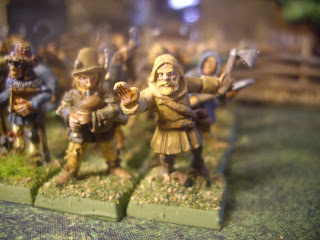And now for something completely different...
Over the last year or so...or maybe more...my old buddy The Troll and I have been getting into WW II naval games. So far we've been using GHQ's Micronauts line and Mongoose Games'
Victory At Sea rules.
The Micronauts are astonishingly detailed and quite lovely. This is all very new to me, so in my efforts to get to a completed fleet, I've been leaving a trail of plasticard clippings, Vallejo water texture puddles and broken and ruined models in my wake for some time. Still, by sticking to it, by starting with small ships instead of big ships, and by refusing to cry, panic or throw a model out the window more than once in a sitting, I have finally managed to successfully assemble and paint the foundation of my tiny Kriegsmarine. I also have a tiny Royal Navy but I'm not quite happy with them and want to make some changes to them before I call them finished, and move on to the big stuff.
So here's the first wave.
KMS Nurnberg:
Nurnberg was one of the two first Micronauts I purchased. I picked her and
HMS Belfast off a rack at Enfilade more or less at random. I wanted two smallish ships which could fight each other so I could get a feel for the VAS rules.
Nurnberg was the second of the two-ship Leipzig class of light cruisers and spent the war engaged in mine laying activities and as a training ship. She was captured intact by the British at the end of the war.
KMS Emden: I chose the
Nurnberg at random, but I picked the
Emden because I thought she had an interesting story. That ended up being a theme. It's the
tale of a ship that gets me interested in modeling it. Entering the Kriegsmarine in 1925, the
Emden was the first large warship built by Germany after WW 1. Thanks to the restrictions of the treaty of Versailles, her armament was very light, and by the outbreak of the war she was considered to be something of an antique. Like Nurnberg, she spent most of the war as a trainer and a mine layer.
Emden was involved in one of the very first clashes between British and German forces, when, on Sept 3, 1939 she was attacked by three squadrons of RAF bombers.
By a weird twist of fate one of these bombers was piloted by a certain Flight Officer Henry Emden.
Emden shot down Emden, who died when he crashed his plane into the bow of his namesake and nemesis. In the waning months of the war,
Emden was tasked with the removal of Paul von Hindenburg's remains from East Prussia in order to keep them out of the hands of the Russians. She was later mauled and wrecked by British bombers while undergoing repairs in Kiel harbor.
KMS Koln:
Koln was one of the three Konigsberg or 'K' class light cruisers. All three K class vessels fought in the Norwegian campaign but
Koln was the only one to survive it. Koln's other wartime activities included mine laying and providing naval gunfire support for Army Group North. Interestingly, for a time in 1942 she carried experimental FL 282 helicopters. Unfortunately, GHQ does not provide a helicopter option with your
Koln model. If they did, mine would have one.
Koln was finally sunk in shallow water in Wilhelmshaven harbor by American aircraft, but because she had been holed in only a few feet of water, her belly rested on the bottom while her deck stayed dry. Ignoring the fact of her own sinking, she continued to fight as a static artillery battery until the final hours of the war.
An interesting feature of the K-class cruiser vs other cruisers: note the rear turrets are offset from one another. From what I understand, the gun turrets were just a little too big for the size of the ship, but by offsetting them the designers managed to successfully accommodate them.
1934/36 Class Destroyers:
Wolfgang Zenker unsuccessfully sparred with Polish destroyers and coastal artillery in the first few hours of the war and, along with
Erich Giese and
Erich Koellner, took part in successful mine laying operations along the British coast. Later all three destroyers helped ferry Mountain troops into the Narvik area during the Norwegian campaign. They participated in the bloody fight with the British 10th Destroyer flotilla on 10 April and were later trapped with other German destroyers in the Rombaksfjord by the Battleship HMS Warspite and her own group of escorting destroyers. The crew of the
Wolfgang Zenker fought until they had expended all their ammunition, then, having no way to escape and nothing with which to fight, they scuttled her to keep her out of British hands.
more below the fold




















